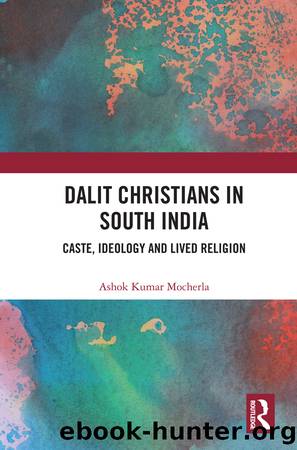Dalit Christians in South India: Caste, Ideology and Lived Religion by Ashok Kumar Mocherla

Author:Ashok Kumar Mocherla [Mocherla, Ashok Kumar]
Language: eng
Format: epub
Tags: Social Science, Sociology, Political Science, General
ISBN: 9781000226706
Google: Jh__DwAAQBAJ
Goodreads: 54218679
Publisher: Taylor & Francis
Published: 2020-11-16T07:59:58+00:00
Sunday worship service
Like the Sunday school, the Sunday worship service, in principle, is open for every caste, gender, class, and age group, but more often than not, the gathering is usually made up of people from the Mala caste alone owing to historical and regional political dynamics. The village Lutheran church being a single-caste church eventually became the strongest symbolic and social hurdle for people from other castes to actively take part in its rituals of the weekly and annual spiritual cycle. Interestingly enough, this does not bother the Lutherans of Dravidapuram, but on the other hand, they claim to be more comfortable with such a situation, for there is no possibility of caste discrimination within the church. There seems to be a strong sentiment among Dalit Christians of Dravidapuram that the Lutheran church had provided them with religion and religiosity minus caste. A customary practice of humming the âchurch bellsâ remains the most popular mode of public communication among the Malas to invite people to attend the worship service. It has been a convention among them that, in all likelihood, the parish pastor must lead the Sunday worship service at the parish headquarters, whereas other member-churches in the parish are usually under the pastoral care of catechists.2 The timing of the Sunday worship service is from 10:30 AM to 1:00 PM. In a cursory examination of the church inside, one cannot help but notice that the Lutheran church in the village does not have benches for the laity, and hence, they must make themselves comfortable on the floor, which is covered with cotton mats.
The spatial arrangement within the church is as interesting as the content of the activities taking place. The spatial distribution inside the church directly corresponds to the normative behaviour of attendees based on the nature of rituals taking place. The Lutheran church in Dravidapuram has got three doors, and each one has its significance. It is the cross-shaped paint on the floor that divides the inside space of the church into four significant parts. The first two parts close to the altar are meant for the pastor and children, and the other two parts are rather large in space meant for the laity, one for women, and one for men, respectively. Each of these spaces is embodied with social acceptance to control the behaviour of individuals when the worship service is in progress. The standard rules and regulations on the subject of how to enter the church, when to go out, which gate to use, and so forth are different for each social group. More often than not, women and children use a particular gate to enter into the church, while the men are instructed to use the main gate, though in principle, it is open for all. These customary practices, with selective restrictions, truly reflect the gender stereotypes and try to reinstate them, with the help of religious and caste norms, in the church.
Even the seating pattern is well planned to cater to the nature
Download
This site does not store any files on its server. We only index and link to content provided by other sites. Please contact the content providers to delete copyright contents if any and email us, we'll remove relevant links or contents immediately.
| Baptist | Book of Common Prayer |
| Calvinist | Episcopalian |
| Inspirational | Lutheran |
| Methodist | Pentecostal & Charismatic |
| Presbyterian | Quaker |
| Seventh-Day Adventist | Shaker |
| Theology |
Fangirl by Rainbow Rowell(9100)
How to Bang a Billionaire by Alexis Hall(8075)
Wonder by R. J. Palacio(8013)
The Space Between by Michelle L. Teichman(6864)
The Thirst by Nesbo Jo(6832)
Assassin’s Fate by Robin Hobb(6134)
Wiseguy by Nicholas Pileggi(5674)
The Night Circus by Erin Morgenstern(5155)
Paper Towns by Green John(5092)
The Kite Runner by Khaled Hosseini(5085)
Bittersweet (True North #1) by Sarina Bowen(4806)
Gerald's Game by Stephen King(4584)
Too Much and Not the Mood by Durga Chew-Bose(4278)
Pillow Thoughts by Courtney Peppernell(4214)
Goodbye Paradise(3729)
Twelve Days of Christmas by Debbie Macomber(3519)
Good by S. Walden(3489)
The Rosie Effect by Graeme Simsion(3375)
The Cellar by Natasha Preston(3264)
